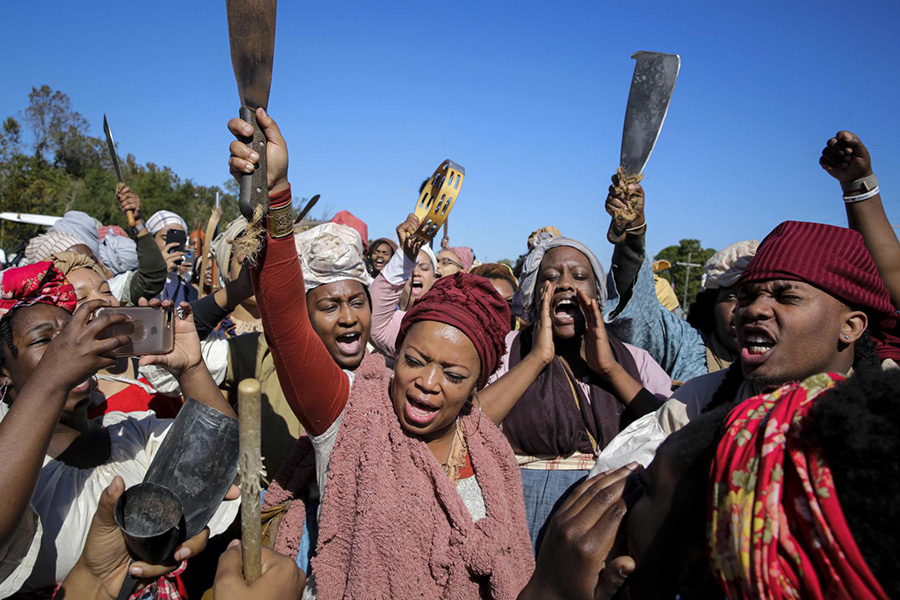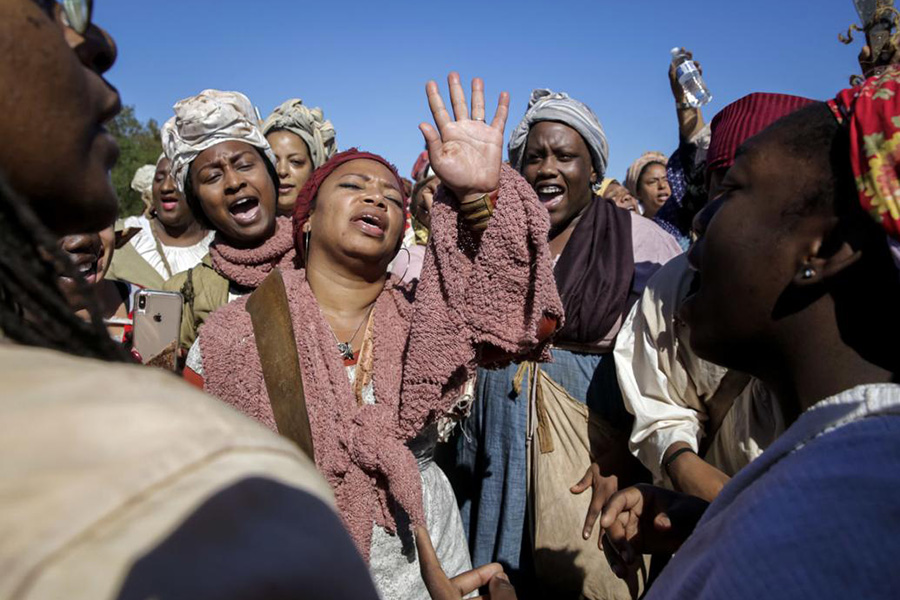What Dread Scott’s Slave Rebellion Reenactment Teaches Us about Cultural Strategy

by The Opportunity Agenda
How do we present a new view of our shared history in ways that illuminate a path forward and unite us toward a shared future?
Part of the answer lies in cultural strategy.
Artist Dread Scott’s Slave Rebellion Reenactment shows us the power of art to not only make history visible but also re-tell it in ways that shift our understanding of what’s possible and what we can achieve when we embody the story of those who came before us—people who resisted, organized for freedom, and took revolutionary action.
By design, Scott’s reenactment invited community members to participate in performance art, and it did so in public view.
Our very own Dr. Tia Smith answered the call and joined with a desire to learn more about the little-known history of the 1811 German Coast Uprising. Her experience mirrored those of other participants, many of whom grew up in the region but were unaware of this historic uprising.
If I knew there were Black people riding horses in the 1800s, I probably would have been a little more intrigued… I only knew Black people were slaves in the 1800s as far as the books that I read.
Taking public action to attract media attention has long been an essential organizing tool. As the saying goes, if newspapers and television networks don’t cover it, it didn’t happen it. Earned media strategies like sit-ins, marches, and other direct actions powerfully shape public conversations about the issues we care about and seek to change.
But for many of us who came up organizing, we often focus more on our political ends than on the narrative possibilities of public art. Limiting creativity to visuals like protest banners and swag in service of policy demands can miss opportunities to tell a more powerful story.
In Dread Scott’s re-telling, he intentionally shifted focus from the brutality of white people to the courageous and heroic character of the hundreds of enslaved people who took revolutionary action together. And that meant changing the way the story ends.
It’s a project about freedom fighters who had a bold vision of getting free by overthrowing the system of enslavement.
Stories repeated over time shape our sense of how the world works and of who holds power to change it. These collections of stories we tell ourselves about our history create narratives that can either uphold the status quo or inspire reform. That’s why nostalgia for the United States’ “founding fathers” is a defining feature of a society still steeped in white supremacy. It’s the powerful elixir that gives rise and structure to mythologies that white benevolence and non-violent direct action alone freed enslaved people or inspired lawmakers to expand civil rights in the 1960s.
When we refuse to engage and repeat these mythologies, we reshape our audiences’ perceptions and understanding of the protagonists in our stories. Enslaved people become the main characters, riding against injustice and armed with an organized vision to win their freedom.
It is historically accurate that the 1811 German Coast Uprising ended in white brutality. That’s important. But in Dread Scott’s 2019 reenactment, the two-day march ends with dancing in the same square in New Orleans where enslaved people met to create community on their days off. This is also true about the people who led that rebellion, and it’s the story that we need today.
I didn’t want to let the ancestors down. And so their energy covered me, and I was so moved… We were collectively lifted.
The connections between our own lives and those of the protagonists in the stories we love are what move us to feel hope, anger, and resolve. That’s why infusing arts and culture into our movements is so essential to inspire collective action.
Despite what white supremacy would have us believe, the colonized, enslaved, and oppressed have always resisted and pursued justice, writing their own history and emerging victorious. We must continue to tell these stories about our legacy and the direct impacts of organizing for freedom and our shared future.
Slave Rebellion Reenactment photo of Dr. Tia Smith courtesy of Scott Threlkeld.
View this post on Instagram
Dread Scott's Slave Rebellion Reenactment

The Guardian follows Dread Scott’s Slave Rebellion Reenactment



